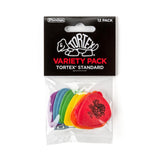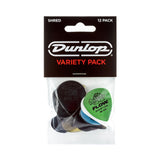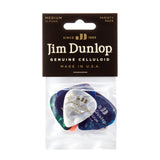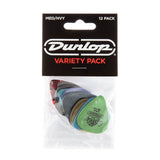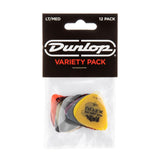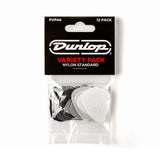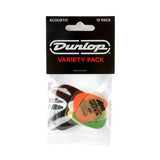Picking the right string gauge is something often overlooked by guitarists who, for the most part, tend stick to what they know. This isn’t something unique to guitarists, we all have our favourite takeaways, pubs, alcoholic beverages, music tastes, you get the picture. Change is hard. Sticking to the same routine is easy. But sometimes change can help you elevate and innovate, and some changes are a lot easier to make than others.
The humble electric guitar string is the conduit down which your creativity pours, traversing through your pickups and manifesting itself via your amplifier speaker. And yet, a lot of guitarists pay surprisingly little attention to the gauge of their string, opting for what they know, or what they think they’re supposed to play. Updating your strings isn’t necessarily just an exercise in maintenance, but can spark new ideas and different mentalities to how you approach your playing.
What is a string gauge?
String Gauge is simply the diameter of your string, measured in 1/1000th of an inch. So as a decimal, a ’10’ gauge string would be 0.010 inches. Strings are referred to by the gauge of their thinnest string, which is why you’ll often hear people refer to sets of strings as ‘9s’ or ‘10s’ when discussing what they’re going to put on their axe next.
Why it’s important
String gauge doesn’t just affect the feel of the guitar, it also hugely affects the tone and sustain. A thicker string will invariably sustain better, with the caveat of being more difficult to handle in terms of bending and fretting. Heavier gauge strings are generally seen to have a warmer tone, hotter output, and superior durability.
A lighter string will offer easier playability but you will have to sacrifice some natural sustain in the process. The deliver a brighter, snappier sound but one drawback is they are more easily broken during heavy picking and string bending.
The Ernie Ball Story
Ernie Ball began making his revered electric guitar and bass strings in 1962. Ernie’s story begins when he met one Leo Fender in 1953 and was so blown away by the early iteration of the solid body electric guitar he became an immediate endorsee of the Fender brand. After opening one of the first known electric guitar shops, Ernie pioneered custom gauge strings after seeing the difficulties his students faced with playing and bending the heavier gauge strings of the time, whilst learning the instrument in his EB Teaching Studio.
Quickly finding favour amongst guitarists of all abilities, Ernie Ball Slinkys have been one of the eminent names in the guitar world ever since, appearing on countless albums and live rigs from pretty much every guitarist you’ve ever heard of. A music lover first and foremost, Ernie continued to innovate his brand throughout the 70s, founding his own guitar company Music Man and developing the Earthwood line of acoustic and bass strings to add to his repertoire.
Gauging your Strings
At Northwest Guitars we know a thing or two about electric guitar strings and we’ve tried them all in their various forms and tunings. We put together this guide to help new and existing guitar players get an idea of the qualities of a string before purchasing. So if you fancy a change in sound and you don’t want to fork out for a new set of pickups or some hardware, read on!
Extra Slinky
The lightest gauge of Ernie Ball strings we offer, the Extra Slinky gauge is great for beginner guitar players because they’re easier to bend and easier to play. Fretting barre chords on these is an absolute dream and if you’re struggling with two tone bends you’ll find they become a hell of a lot easier with a set of these on. These strings are optimal when used in standard tuning, trying to go any lower makes them incredibly loose.
There’s a line of thinking in certain guitar circles that lighter gauge strings are for beginners, or players who aren’t worth their salt. Heavier is better right? Well to fly in the face of this unhealthy convention, Chuck Berry was a known proponent of .008s, as was the legendary Frank Zappa, in fact there are some sources who say Zappa even used .007s! Super shredder Yngwie Malmsteen uses super light strings to assist with speed, as you need a lighter touch to fret them, thus giving you an easier time playing those speedy neo-classical passages. So no, lighter gauge strings aren’t just for those who can’t hack a heavier gauge.
Super Slinky
The Super Slinky set isn’t a huge jump from the Extra Slinky, giving you plenty of ease of use in terms of bending and fretting. They’re great for vintage style guitars and give you a similar performance to the Regular Slinky whilst retaining a bit of a looser feel for easy bending. These .009s work best in Standard Tuning and you could definitely get away with taking them to Drop D if you were that way inclined.
There are plenty of pro guitarists who used these lighter gauge of strings such as Eddie Van Halen, Satriani, Steve Vai, plus many others. As mentioned previously, lighter gauge strings help a lot with speed and fretting efficiency which is why there are some seriously fast players on this list. If you’re switching to these from a heavier gauge you may find you have to adjust your playing style slightly to accommodate the lesser tension, fretting and picking in a lighter fashion.
Regular Slinky
This gauge comes fitted on most guitars as standard and is a nice middle ground between heavier and lighter gauges. You'll find most players use .010s, although this may just purely be down to the fact that that’s what they started with and didn’t see a need to change. The Regular Slinky has a good tension so you can attack them without worrying about fretting or picking out of tune and they work optimally in Standard Tuning or Drop D, you could probably take them down to D Standard if you've got a lighter touch.
There are innumerable guitarists who use .010s on their guitars with everyone from Clapton and Gilmour right through to Zakk Wylde and John Frusciante utilising them. They offer the perfect middle ground between playability and durability, something you need when you step on stage regularly.
Skinny Top Heavy Bottom
The Skinny Top Heavy Bottom is a mashup of two different gauges to give you a lighter feel on the treble strings whilst still allowing you to play chunky riffs on the bass side of your guitar. The standard gauge high strings ensure that your bending and soloing comes with ease and speed whilst there’s plenty of room on the lower bass strings for tuning to Drop D, or even utilising more unusual tunings like BADGBe à la Tom Morello or AADGBe like some math-y rock bands are known to use.
There isn’t much documented use of pro players and these strings (although yours truly loves them), however there is Internet forum talk of guitarists like Kirk Hammett and James Hetfield using this more esoteric string gauge. They play slightly unevenly due to the difference in gauge, so if you switch to a set of these it may take a little getting used to when fretting chords and doing your scale runs, however the inherent versatility of these strings more than makes up for it, you can even drop these to D standard or Drop C and they won’t feel loose at all.
Power Slinky
The Power Slinky gauge will work in standard tuning, however they are best utilised half a step or a whole step down in Eb Standard or D Standard. These strings are perfect for heavier styles and give you plenty of chug on the bass strings. You’ll find string bending and barre chords slightly more difficult on these when tuned to Standard if you’re used to .009s or .010s.
Due to their chunkier feel and optimal working range in lower tunings, you’d be forgiven for thinking that only players of heavier styles string their axes with these, but a lot of blues and rock players like to string their axes with .011 gauge strings. Guitar legends like Slash, Joe Bonamassa, and Jeff Beck all prefer this slightly heavier gauge on their guitars, mainly due to the increased sustain and durability.
Not Even Slinky
The Not Even Slinky takes us further down the scale of guitar tunings, best for use in D Standard, Drop C and C Standard. Here we’re stepping into the realm of heavier playing and if you’re new to the guitar these strings will not go easy on your fingers! Fretting barre chords on a set of these requires developed hand strength and technique, unless you’re going right down to a lower tuning like C or B Standard.
There aren’t huge amounts of information on players who use this gauge, but it’s fair to assume that the majority of players using these are in the realms of hard rock and metal, as they are so good for downtuning. That said, Stevie Ray Vaughn famously used .013s tuned to Eb, but for us mere mortals you might find bending and fretting with your guitar setup like that pretty difficult. Trying to play this gauge in standard is nigh on impossible (trust us we’ve tried it) but once you drop them down to C Standard they’ll feel as sleek as a set of Regular Slinkys!
A Note on Scale Length
These notes on string gauge are optimised for a scale length of 25.5 inches, what you’d find on most Fender models like the Strat, Tele and Jazzmaster. If you’re using an LP style guitar you need to take into account the shorter scale of 24.75 inches. The shorter scale will make the strings feel easier to play, so a set of regular .010s on a LP will probably feel more like a set of .009s on a Strat. Make sure you take this into account when making a purchase, you may want to go a step up in gauge if your current set feels too loose or ‘slinky’.
In Conclusion
Your strings are one of the primary sources of your sound, so ensuring you have the right gauge for your guitar and style of play can make a massive difference in your tone and in your playing. If you’re one of those players who always reaches for that same set, consider trying out something different, you never know how it might kick start your creative juices and get you playing in a whole new way!
Check out all of our Ernie Ball Electric Guitar Strings here.


















